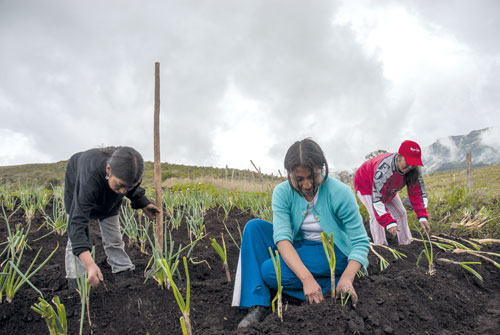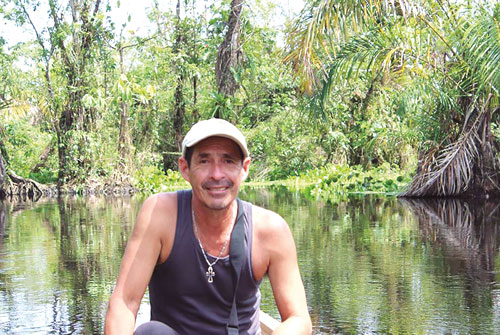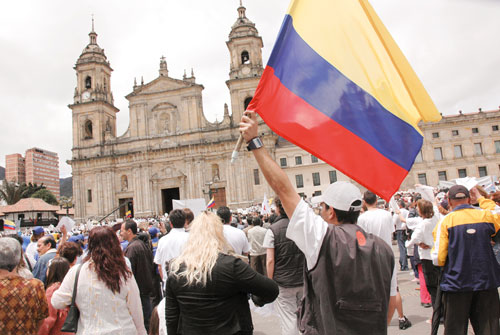Since the age of 13, Óscar Salazar has worked tirelessly for peace in Colombia. He was born in Urabá, a thriving region but sadly besieged by violence, like many Colombian territories. Throughout this journey, he has personally endured the harsh realities of war. He was a witness and part of different peace agreements, such as the one signed with the M-19 in 1990, and participated in the Havana dialogs as a delegate of the Social Bureau of Victims, to make his contribution in the construction of the Peace Agreement with the Farcsigned in October 2016.
Today, seven years after the start of the implementation of the six points of the Agreement, this social leader who has traveled inch by inch the northwest of the country, makes a bittersweet balance. He recognizes significant achievements such as transitional justice, but regrets that points such as reparation for victims are still lagging behind.
“We have reached today the staggering number of nearly 10 million victims of the armed conflict, of which only 1.6 million have been repaired, according to the Unidad de Víctimas (Victims Unit). This is because there hasn't been enough budget. Sadly, this repair would last for around 80 years. However, more important than a pecuniary reparation, it is a comprehensive reparation that allows us to know the truth,” he says. In this period of implementing what has been agreed, there are numerous nuances and contrasts that have been presented, which has attracted the attention of many academics who have followed this stage. Researchers of Universidad del Rosario and other institutions of the country, put the magnifying glass to this issue from an interdisciplinary approach, in order to analyze the different scenarios that were erected once the Peace Agreement was signed. This led to the development of an important research project condensed into a book entitled “The Post-agreement in Colombia: situational processes, temporality, territory and materiality.”
The book explores the history of the conflict, the transition of the Farc, the Territorial Spaces of Training and Reincorporation (ETCR, by its acronym in Spanish), the supply chains and the construction of peace, among others. However, beyond evaluating the points of the Agreement, this publication contains a series of reflections and analyzes on the processes that have been lived around the subject.
The signing of the Peace Agreement with the Farc in October 2016 began a variety of changes in many regions of the country, with stark contrasts: several communities are now facing the presence of dissidents and other armed actors, while in some areas important social processes involving ex-combatants and civil society have developed. This is reflected in the book ‘The postagreement in Colombia’, an initiative of Universidad del Rosario supported by the Fritz Thyssen Foundation of Germany.
The Challenges of Reintegration
One of the pillars of the Peace Agreement with the Farc is the reincorporation of the guerrilla members into civilian life, taking into account that it was the largest guerrilla in the history of Colombia, which came to have about 30,000 combatants, as recorded by Mario Aguilera Peña in his article The Farc: rise and fall of the war model. More than 13,000 guerrilla members reintegrated after peace was sealed with the former Farc; of them, 94.9 percent continue to comply with their process of returning to normalcy, according to data from the Truth Commission.
“I believe that there has been an effort by various institutions to articulate a policy of multidimensional reincorporation in social, economic and psychosocial issues,” says Jairo Baquero, professor in the School of Human Sciences at Universidad del Rosario and academic editor of the book.
However, this path has not been without thorns. While most ex-combatants gradually managed to adapt to a new way of life in the Territorial Training and Reincorporation Spaces, the status quo was altered by the emergence of some dissidents, shielded by alleged breaches by the government of the day.
In August 2019, the “second Marquetalia” was born, composed of the largest faction of dissidents of the former Farc and commanded by alias Iván Márquez, which seeks to retake its former control areas and dispute other territories. In addition, new terrorist groups began to emerge and alliances began to be generated in areas such as the Amazon and Putumayo, historically marginalized and where the coca economy took hold.
“The space that Farc left in some areas is beginning to be filled by new armed groups, given that the state did not fill it at the time, as many analysts have expressed. Other groups, such as the ELN and the Gaitanist Self-Defense Forces (also known as the Clan del Golfo), entered to fight for control, along with the so-called dissidents,” Baquero says.
As a result, the territories are beginning to face new dynamics that constitute a great challenge for the State. This situation makes it difficult to speak of a peace achieved today, when a territorially differentiated post-agreement is in sight.
The land tenure process needs to be addressed more broadly, in a way that responds to current challenges.
A turning point in forms of violence
Andrés Restrepo, a researcher at the Center for Regional Studies of the South (Cersur, by its acronym in Spanish), and Jhenny Amaya, a member of the International Law and Peace Research Group in the Faculty of Legal and Political Sciences atUniversidad Surcolombiana, joined in the construction of the book with the chapter “The Farc Transition: The Last Days of the Southern Bloc.” They have been key witnesses of the transition in Huila and Caquetá, departments heavily besieged by violence, which are again battlegrounds for other actors.
“What we are seeing today is not a guerrilla war like the one we experienced with the Farc. What we are seeing is an armed group that murders social leaders, kills reintegrated people, extorts money, and does not confront the state or the security forces. Recruiting and trading marijuana… There is a reconfiguration of armed actors with other types of interests,” Restrepo says.
In the case of the south of the country, he says,it involves the control of the marijuana trafficking corridors that go from Cauca, through Huila, Caquetá and arrive in Brazil, framed within a war economy. “One of the main interests of the new guerrillas is the control of drug trafficking and the rents of the illegal economy, which became the main reason for many guerrillas not to accept the agreement, since it involved renouncing the income derived from their activity.”
Researcher Amaya adds that there are not only favorable scenarios in crime and illegality that attract ex-combatants, but also a breeding ground for the divergences of the current rulers. “Since peace is not a nation-state project, but a project of different political leaders, there are too many uncertainties for the sustainability of a process and the Agreement,” she adds.
Along with these realities live other problems. “It is important to talk about multiple forms of violence. Gender-based violence persists in many parts of the country. In some regions conflicts coexist over the use of natural resources, over water, as in the case of southern Tolima, which is outlined in our publication,” says Baquero.
However, the three researchers agree that building peace is a long-term process that naturally involves challenges, and emphasize that signing an agreement does not mean that violence automatically ends, but rather represents a substantial step forward on that path.
Steps Towards Peace: Productive Projects
- The “From the Root”(Desde la Raíz), program of the Agency for Reincorporation and Standardization (RNA, by its acronym in Spanish) aimsto highlight of some of the initiatives of those who left the weapons. Here are just a few:
- Association of Marquetalian Women Producers (Planadas, Tolima).
- Prints Álix Sofía (Granada, Meta).
- Poultry Santa Teresa (Icononzo, Tolima).
- Corporación Trabajo Dignidad y Solidaridad-TRADSO (Bogotá, D.C.).
- Marquetalia Cooperative Coffee Threshing for a Better Future - Coomumarfu (Planadas, Tolima).
- Trochas Marketing Cooperative (which groups 23 cooperatives or associations from several regions).
What Lies Ahead for Colombia?
To attempt to explain what is happening in Colombia in the framework of the post-agreement, Professor Jairo Baquero cites the concepts of positive peace and negative peace of the Norwegian sociologist Johan Galtung. “Negative peace is the laying down of arms. Positive peace involves reducing the structural causes that generated violence: poverty, exclusion, stigmatization… A series of deeper problems. There has been significant progress in negative peace with the signing of the Agreement, with the laying down of arms. This is also true regarding the Special Jurisdiction for Peace (JEP, by its acronym in Spanish), the Truth Commission, and the body addressing cases of missing persons,” he notes.
Researcher Jhenny Amaya adds to this perspective: “To the detonated munitions, we could add the hundreds of productive projects, the initiatives that have signatories of peace articulated with civil society; even housing projects with victims of the armed conflict and reconciliation processes through community projects from gastronomy, art and culture. Moreover, the academy has also devoted itself to studying the issue of peace from various perspectives,” she states.
For most of his life, Óscar Salazar, a social leader from Urabá, has worked for peace in Colombia. His main motto has been the comprehensive reparation of the victims.
Peace with a Territorial Emphasis
The Peace Agreement with the Farc conceives of the territories as its backbone, so much so that it identifies and prioritizes, due to its high indicators of poverty, exclusion and inequality, 170 municipalities historically affected by violence. These social gaps have meant that the implementation of the Agreement is not a uniform or homogeneous process.
This is what researcher Baquero calls “multiple temporalities in the regions of Colombia.” He states that while some territories are highly integrated into the normalized and legal market, with optimal education and health services, others have remained stagnant, lack health facilities and offer very few economic opportunities.
“Although there has been an emphasis on issues such as small infrastructure projects, parks and sidewalks, attention has been lacking on tertiary roads,” Baquero continues, adding that “this is a problem that impacts elements of the Peace Agreement, such as the Comprehensive Rural Reform (RRI) and the National Integral Program for the Substitution of Illicit Crops (PNIS). If there are no roads or exits for agricultural products, how do we ask people to live off agriculture? How can we move forward on other crops that replace coca if structural problems persist?”
Furthermore, it stresses that the land tenure process needs to be addressed more broadly, in a way that responds to current challenges. It must start, from her point of view, from the new trends in food, agroecological and production types, “for which it is essential to analyze in depth how new demands are articulated with the old problem of land redistribution that remains in force.”
She also highlights the instability and uncertainty that fluctuating prices of products such as cocoa, coffee, and avocado create for many farming families—crops with which the state seeks to compete against the economies of coca and marijuana.
“The participation of the peasants in these chains is not linear; people enter them but are also expelled, win and lose. Latin American countries specialized as commodity producers, but more recent political-economy analyzes emphasize the need to add value. As is being done in some cases, we must form companies that can generate value for these products and review how to better articulate the development processes in these regions.”
In this context, Professor Baquero underscores the urgency of proposing a broader concept of territories of peace, which includes all the aspects contemplated in the Agreement and which provides a comprehensive opportunity for populations historically bankrupted not only by war, but also by exclusion. This approach would help prevent the reproduction of the causes that have commonly triggered violence in numerous regions.
“I believe that there has been an effort by various institutions to articulate a policy of multidimensional reincorporation in social, economic and psychosocial issues,” says Jairo Baquero, professor in the School of Human Sciences at Universidad del Rosario.
Productive Bets: A Step Towards Integration
Even with the difficulties that the implementation of the Agreement has faced, it has been possible to weave valuable social and entrepreneurial processes that link the signatories and local communities. For example, around coffee, initiatives have emerged in southern Tolima involving the Nasa indigenous community and local farmers from the Gaitania district in the municipality of Planadas, leading to the creation of brands such as Tercer Acuerdo and Café Marquetalia..
“Productive, individual, cooperative and collective bets were initiated, which today face many challenges, but in that first part of the history of the transition generated a lot of expectation and meant the hope and motivation to which many were attached to continue,” emphasizes researcher Amaya.
Women have played a leading role in some of these projects around the Agreement. They lead several peasant associations that are booming today and one of the best examples is given precisely around coffee.
“Women's participation in coffee-growing economies starts from rethinking the roles of the household, since land tenure is in the name of men. To the extent that women have land titles, they can own the coffee plantation and generate their own brands,” Baquero says.
Another example of success is the participation of indigenous women as guardians of native and creole seeds of corn, cassava, banana, beans and vegetables in Tolima. They have combined traditional knowledge with knowledge from agroecology, and have applied techniques such as water harvesting, which consists of a rainwater harvesting system for domestic and agricultural use. This leadership has allowed them to empower themselves within their communities.
Even inside the ETCR spaces, the role of the former guerrillas was also reviewed. There is an awareness of these leaders, a need to rethink these roles and put peace in the face of women as synonymous with transformation and entrepreneurship.
While it is true that Colombia faces a panorama of contrasts and challenges around peace, there is also a political transition with the Government of Gustavo Petro, a situation that generates expectation in the different sectors involved in the Agreement, whose implementation reaches 30 percent according to the Kroc Institute of International Peace Studies in its report of the Barometer Initiative of the Matrix of Peace Agreements, in the sixth year of the Agreement
Although the anxiety is felt in some regions, there is still hope that one day the bullets may be completely silenced and that peace may be spoken of without hesitation.
As new political winds wave, Óscar Salazar, the social leader of Urabá who has pursued peace all his life as one who seeks an oasis, continues with his oars to the fullest. While he feels the implementation is moving slowly, his momentum is unwavering and he exorcizes his doubts with a phrase that is perhaps his life mantra to persevere in the social leadership he assumed as a teenager: “We cannot remain a country that refuses to live in peace.”
Farc chess
One of the relevant aspects in the framework of the postagreement in Colombia has to do with materialities, in other words, those tangible elements that make explicit the end of the conflict with the Farc.
This symbolism highlights an initiative by the researcher Andrés Restrepo, who was an active part of the monitoring mechanism and the process of disarming this guerrilla in the southwest of the country. He says that one night, while they were destroying more than 80 coves that the southern bloc in Caquetá gave up, he noticed that the detonations showed interesting figures: “The bullets melted into each other and took very nice shapes.”
From there came an idea that could be realized: “I managed to get my colleagues to allow me to keep 32 pieces. At that time I was very inspired by the works of Goya during the Spanish Civil War, by the beauty of that art despite being motivated by such cruel images.” With Colombian and foreign military personnel, as well as guerrillas involved in this mission, Restrepo began to play with those 32 bullets as they told stories related to the conflict. This is how the so-called “Postwar Chess” emerged, which, more than a game, is proof that Colombia began a transition to peace; it is a sign that despite the shortcomings and the ups and downs, an agreement was signed with the oldest guerrillas in the world, a process of laying down arms was carried out and an important step was taken to start writing a new history. Researcher Restrepo describes this moment as “the hinge of history”, since it could be said that the country is in the dilemma of transition and repetition. “Either we innovate or we fail, as the great educator Simón Rodríguez said. We transform ourselves or repeat history. We go straight or we fall off the tightrope. The latter would mean lasting another 50 years in an armed conflict. We are in the hinge of history,” he says, paraphrasing the sociologist María Teresa Uribe. 89





